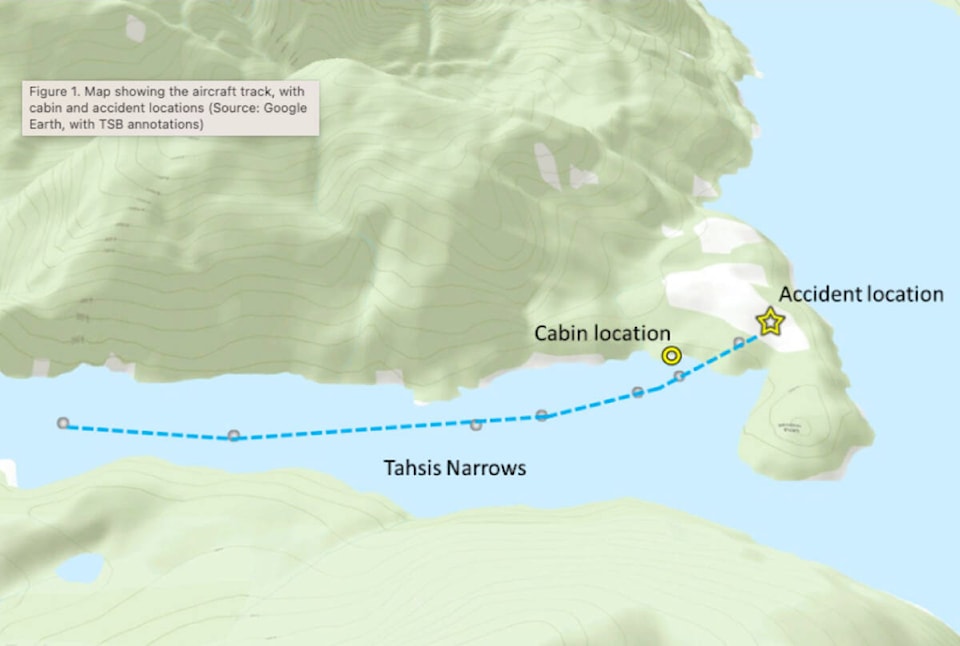A floatplane that crashed near Tahsis last year likely hit an unexpected boat wake or an object while landing that caused it to bounce off the ocean and crash into nearby trees, according to the Transportation Safety Board of Canada.
The TSB released the findings of a fatal June 2023 crash on May 8, 2024, after concluding its investigation into the incident that killed two people and significantly injured another.
The privately registered Quest Kodiak 100 amphibious float-equipped aircraft left Masset Airport on June 20 heading for a cabin located roughly 60 nautical miles northwest of the Tofino Long Beach Airport.
The pilot aimed for a straight-in water landing in Tahsis Narrows, but bounced off the water in the initial attempt and, on the second attempt, its left float made contact with either an unexpected boat wake or unidentified object.
The force of the contact bounced the plane roughly 10 metres in the air, banking to the right and ultimately crashing into nearby trees and terrain.
The pilot and one passenger died. One passenger received significant injuries and another passenger escaped with minor injuries.
The aircraft was destroyed and the crash area caught fire.
The report explains the pilot was licenced and had roughly 250 flight hours on the floatplane that crashed. The pilot had also landed safely in the same area five days prior.
“According to information gathered during the investigation, there was no indication that the pilot’s performance was affected by medical or physiological factors,” the report reads.
It adds that the wind was blowing at roughly 4-6 knots at the time of the crash with small wave activity occurring, though the surrounding mountains cause unpredictable wind patterns in the area.
“[W]hen wind blows over large mountain ridges, the wind blowing up the windward slope, in a stable atmosphere, is usually relatively smooth. However, it spills rapidly down the leeward side, setting up strong downdrafts and causing turbulence in a situation which can be compared to water flowing down a rough stream bed,” the report reads, citing Sparky Imeson’s Mountain Flying. “These downdrafts may be dangerous and can place an aircraft in a position from which it might not be able to recover.”
The investigation found no evidence of issues with the aircraft’s equipment or maintenance that would have prevented it from operating normally during the flight.
“The aircraft struck trees and impacted the terrain in an upright position and on its right side. A post-impact fire began and the aircraft was destroyed. The floats and wings had detached from the fuselage,” the report reads.
“Owing to damage from the fire, the TSB was unable to determine the engine control position or condition of the floats. The propeller blade damage was consistent with the engine producing power at the time of impact. The wheels were retracted.”
The report includes recommendations for pilots following the incident that include circling an area three times to assess wind strength and direction, check for obstacles like deadheads and boaters in the landing area as well as any obstructions like trees, buildings and wires.
“It is usually a good practice to circle the area of intended landing and examine it thoroughly for obstructions such as pilings or floating debris, and to note the direction of movement of any boats that may be in or moving toward the intended landing site,” the report reads, citing a Federal Aviation Administration handbook.
“Evaluation of the landing area should include approach and departure paths. Terrain that rises faster than the seaplane can climb is an obvious consideration, both for the eventual takeoff as well as in case of a go-around during landing. If climbout over the terrain is not easily within the seaplane’s capabilities, be certain there is sufficient room to make a gentle turn back over the water for climb.”
It adds that whenever landing conditions are unsatisfactory, a pilot should always climb back up to a safe altitude and re-evaluate the situation.
“Remember that it is often best to make a gentle climbing turn back over the water to gain altitude, rather than climbing out over a shoreline with rising terrain or noise-sensitive areas,” it reads.
Don’t miss out on reading the latest local, provincial and national news. Join our community and receive daily news alerts & breaking news, right to your inbox. .
READ MORE:
READ MORE:
READ MORE: Tofino RCMP praises Ahousaht First Nation’s response to plane crash



